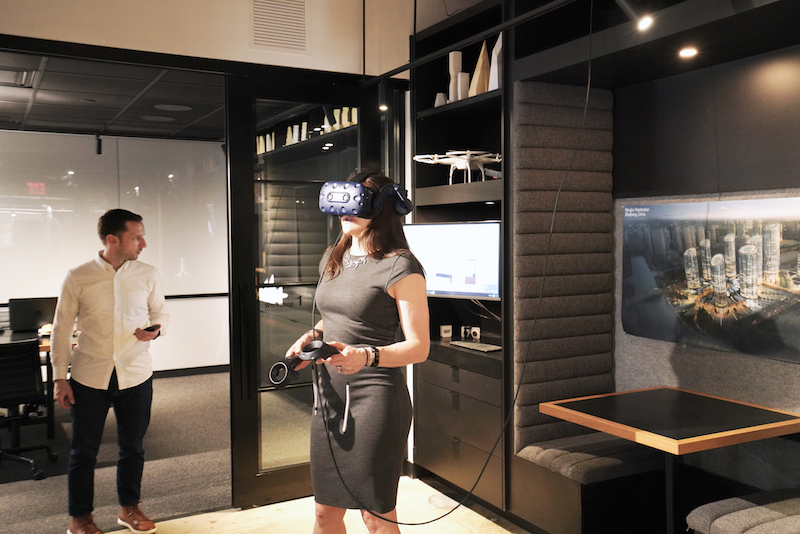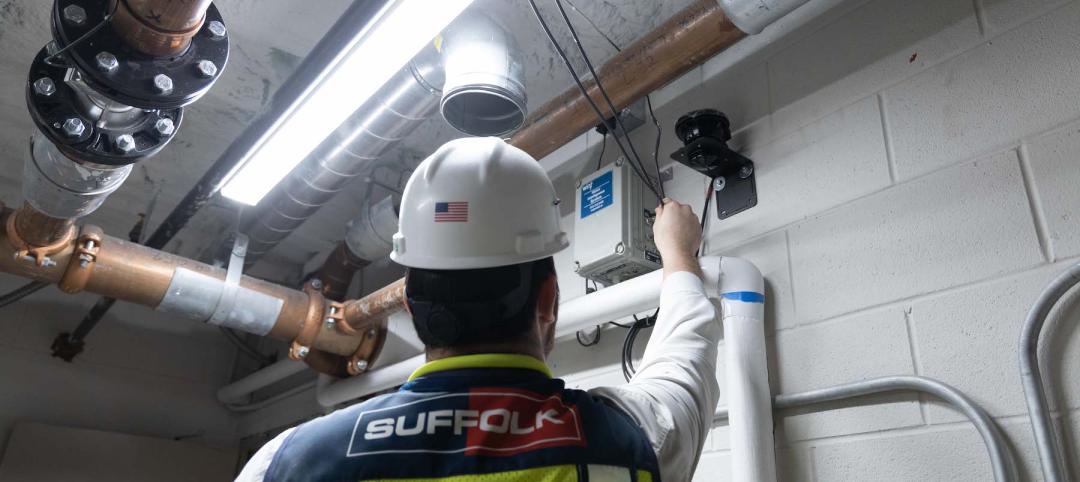Woods Bagot, one of the industry’s oldest architectural firms, is embracing the future of design and client relations with virtual reality apps that offer customizable interfaces.
For a number of years, the firm has played with a variety of virtual reality apps for design presentations, including ones that allow for 360-degree viewing.
About a year ago, Woods Bagot, with 16 studios around the world, developed its own VR app, driven by game-engine technology, with the goal being to give clients a unique spatial and human experience “that you can’t get from a rendering or even animation,” says Shane Burger, Woods Bagot’s Principal and Global Leader of Technical Innovation.
The “bespoke” app works like this: Woods Bagot creates what Burger calls a “white-card rendering” that puts the client in the VR space and allows him or her to move from room to room. The environment is designed, but in a very early concept stage.
The apps, so far at least, have been most effective for designing interiors, says Burger.
The beauty of using VR apps in early design stages is that there’s a fairly quick turnaround so that a more refined design can be presented to the client either in Woods Bagot’s New York office—which includes a 10x15-ft space equipped with an HTC Vive headset and screen—or by using a phone app with a portable headset like Google cardboard.
One of the benefits of having clients install the apps on their phones, explains Burger, is that they can receive Woods Bagot’s design proposals right away, and that multiple people can view the design simultaneously. (The designs are accessed via a web link.)
Woods Bagot has developed apps for both iOS and Android phones.
The first time the firm deployed a customizable VR app was to bid on a project with a technology client. Since then, Woods Bagot has made a number of refinements to its platform, such as adding more interfaces that allow clients to “walk through” multiple floors of the building. Woods Bagot is now developing apps that allow users to flip through white-card and materials environments within VR.
The biggest “learning step” in virtual design, says Burger, has been “to keep our options open, and to keep the user interface really simple, because most clients don’t have a lot of experience with VR.” Indeed, when Woods Bagot walks a client through the process, it typically has the user stay relatively stationary to get used to the VR surroundings.
Burger says most users are less disoriented when they use a mobile app because the viewer doesn’t block their peripheral vision.
VR is becoming a more sophisticated design tool for Woods Bagot, whose visualization team in London has been generating renderings right from virtual reality. Woods Bagot also recently used its VR app with a client for a project in Japan with 18 floors.
Woods Bagot is striving to get to the point where using a customized VR app enables a conversation with clients “that wouldn’t have happened otherwise,” says Burger.
Related Stories
Mass Timber | May 3, 2023
Gensler-designed mid-rise will be Houston’s first mass timber commercial office building
A Houston project plans to achieve two firsts: the city’s first mass timber commercial office project, and the state of Texas’s first commercial office building targeting net zero energy operational carbon upon completion next year. Framework @ Block 10 is owned and managed by Hicks Ventures, a Houston-based development company.
AEC Tech | May 1, 2023
Utilizing computer vision, AI technology for visual jobsite tasks
Burns & McDonnell breaks down three ways computer vision can effectively assist workers on the job site, from project progress to safety measures.
Design Innovation Report | Apr 27, 2023
BD+C's 2023 Design Innovation Report
Building Design+Construction’s Design Innovation Report presents projects, spaces, and initiatives—and the AEC professionals behind them—that push the boundaries of building design. This year, we feature four novel projects and one building science innovation.
Building Technology | Apr 24, 2023
Let’s chat about AI: How design and construction firms are using ChatGPT
Tech-savvy AEC firms that already use artificial intelligence to enhance their work view the startling evolution of ChatGPT mostly in a positive light as a potential tool for sharing information and training employees and trade partners. However, the efficacy of ChatGPT is likely to rest on the construction industry’s aggregation of quality data that, until recently, has been underwhelming for getting the greatest bang from AI and machine learning.
Design Innovation Report | Apr 19, 2023
HDR uses artificial intelligence tools to help design a vital health clinic in India
Architects from HDR worked pro bono with iKure, a technology-centric healthcare provider, to build a healthcare clinic in rural India.
3D Printing | Apr 11, 2023
University of Michigan’s DART Laboratory unveils Shell Wall—a concrete wall that’s lightweight and freeform 3D printed
The University of Michigan’s DART Laboratory has unveiled a new product called Shell Wall—which the organization describes as the first lightweight, freeform 3D printed and structurally reinforced concrete wall. The innovative product leverages DART Laboratory’s research and development on the use of 3D-printing technology to build structures that require less concrete.
Contractors | Apr 10, 2023
What makes prefabrication work? Factors every construction project should consider
There are many factors requiring careful consideration when determining whether a project is a good fit for prefabrication. JE Dunn’s Brian Burkett breaks down the most important considerations.
Smart Buildings | Apr 7, 2023
Carnegie Mellon University's research on advanced building sensors provokes heated controversy
A research project to test next-generation building sensors at Carnegie Mellon University provoked intense debate over the privacy implications of widespread deployment of the devices in a new 90,000-sf building. The light-switch-size devices, capable of measuring 12 types of data including motion and sound, were mounted in more than 300 locations throughout the building.
Cladding and Facade Systems | Apr 5, 2023
Façade innovation: University of Stuttgart tests a ‘saturated building skin’ for lessening heat islands
HydroSKIN is a façade made with textiles that stores rainwater and uses it later to cool hot building exteriors. The façade innovation consists of an external, multilayered 3D textile that acts as a water collector and evaporator.
Project + Process Innovation | Mar 22, 2023
Onsite prefabrication for healthcare construction: It's more than a process, it's a partnership
Prefabrication can help project teams navigate an uncertain market. GBBN's Mickey LeRoy, AIA, ACHA, LEED AP, explains the difference between onsite and offsite prefabrication methods for healthcare construction projects.
















